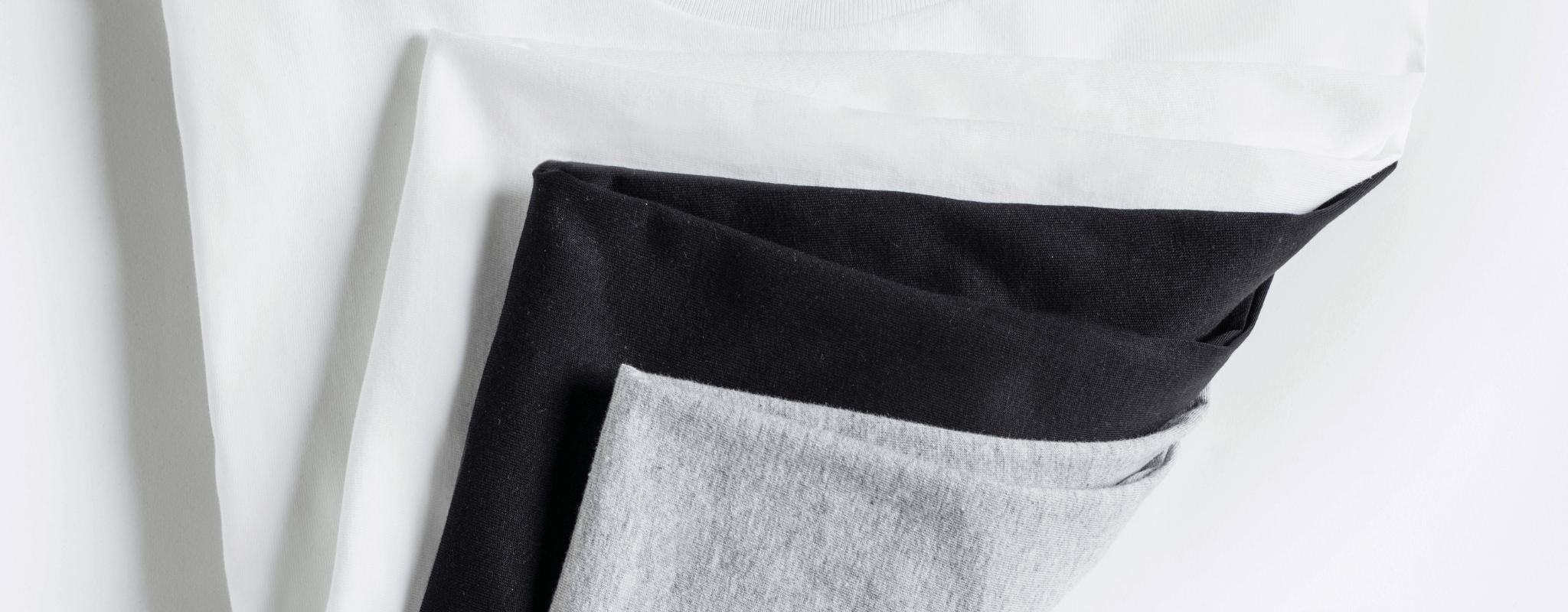Fashion-savvy peeps know that the heaviness and quality of a fabric is directly related to its density and GSM. The density and fabric weight of a textile determine its durability, resistance, and robustness based on how densely it is woven. But how can you tell which GSM numbers indicate quality? At SANVT, we talk about fabric weight and provide a guide to GSM to ensure that you purchase high-quality products.
First off, let's get one thing straight: the weight of a fabric matters! And if you've always thought of fabric density in clothing as fairly irrelevant, we'd like to convince you otherwise in this article. Because in addition to the material choice, the density and weight of the textile are critical factors in determining the quality, durability, functionality and even comfort of a garment. After all, who wants to sweat in heavy textiles in summer or freeze in lightly woven fabrics in winter? We, therefore, offer a guide to the best GSM for different cotton garments, depending on the season. Now, let's break it down.
Ideal GSM For Different Cotton Garments At a Glance:
- Summer T-Shirt: 120-160 g/m2
- Regular T-Shirt: 160-190g/m2
- Winter T-Shirt: 200-300 g/m2
- Classic Chino: 250-300 g/m2
- Winter Chino: 350-450 g/m2
- Sweatshirt: 300-400 g/m2
 Our Heavyweight Chino in 420 g/m2 vs. our Smart Chino in 290 g/m2
Our Heavyweight Chino in 420 g/m2 vs. our Smart Chino in 290 g/m2
What Determines Fabric Density & Fabric Weight?
Fabric density refers to how tightly the fibres of a fabric are woven together. The denser the weave, the heavier the fabric. And when we say heavy, we mean good heavy. After all, a higher fabric density usually means more durability and resistance. The fabric weight is often a vital characteristic for textile quality and measures the density and weight of the material per square meter. But how to know the fabric weight? That's where GSM comes in.
@chrisdelmarle in SANVT Heavyweight Chino in Grey. Perfect for the colder days.
What Does GSM Stand For?
GSM stands for "Gram per Square Meter" (g/m2) and is a unit used to measure the weight of textiles. The higher the GSM, the heavier the fabric. Simple enough, right? But here's the thing: not all high GSM fabrics are created equally. There are many factors that determine the quality of a textile, such as the type of material, the production process, and the weaving technique. For instance, a thick cotton fabric with a high GSM might be perfect for winter clothes, but a lighter cotton fabric with a lower GSM might be more suitable for summer outfits and underwear. And let's not forget about the different weights of various textile fibres!

What GSM Indicates Quality?
So, how much GSM should your basics measure? It all depends on the type of garment, the season, and the material. Let's take cotton as an example: a lightweight summer t-shirt made of jersey should have a GSM number between 120-160, while a heavyweight t-shirt for winter should measure between 200-300 g/m2. As for trousers, chinos made of twill cotton should have a GSM between 250-300 for a classic look that can be worn all-year round, and between 350-450 g/m2 for a winter-ready heavyweight chino. And to compare: a high-quality French Terry loopback sweatshirt made from high-quality cotton should measure between 300-400 g/m2.
But wait, there's more! You should also pay attention to the weave style and the material itself. Synthetic materials are a no-no if you want high-quality and sustainable textiles. Instead, go for organic natural fibres like cotton, lyocell, linen, hemp, or bamboo.
 Our Heavyweight T-Shirt in 235 g/m2 vs. our Lightweight T-Shirt in 160 g/m2
Our Heavyweight T-Shirt in 235 g/m2 vs. our Lightweight T-Shirt in 160 g/m2
Are Lightweight Fabrics Always of Poor Quality?
No, lightweight fabrics aren't always bad quality. Take (peace) silk or Lyocell, for example. They are naturally light – even when densely woven – and therefore ideal for spring and summer. Our ultra-light summer t-shirt is made from a unique blend of Lyocell and premium cotton, which makes it extra breathable and comfy, without sacrificing durability. You can check out more differences between light and heavy t-shirts here.
Fabric Weight & GSM: Conclusion
So, there you have it, folks. Now you know all about GSM and fabric weight, and you're ready to make some smart shopping decisions. Don't forget to opt for sustainable and high-quality pieces, and grab different GSM weights to cover all seasons. At SANVT, we've got you covered with our fairly produced and eco-friendly essentials in different fabric densities. Our t-shirts come in three different weights, so you can choose the one that's perfect for you. Besides the ultra-light summer t-shirt in 160 g/m2, you will find our perfect t-shirt with a GSM of 185 – ideal for transitional seasons – and our heavy t-shirt for winter with a fabric weight of 235 g/m2.

If you're still in doubt, download our GSM guide to help you choose the best density for different basics. Happy shopping!


